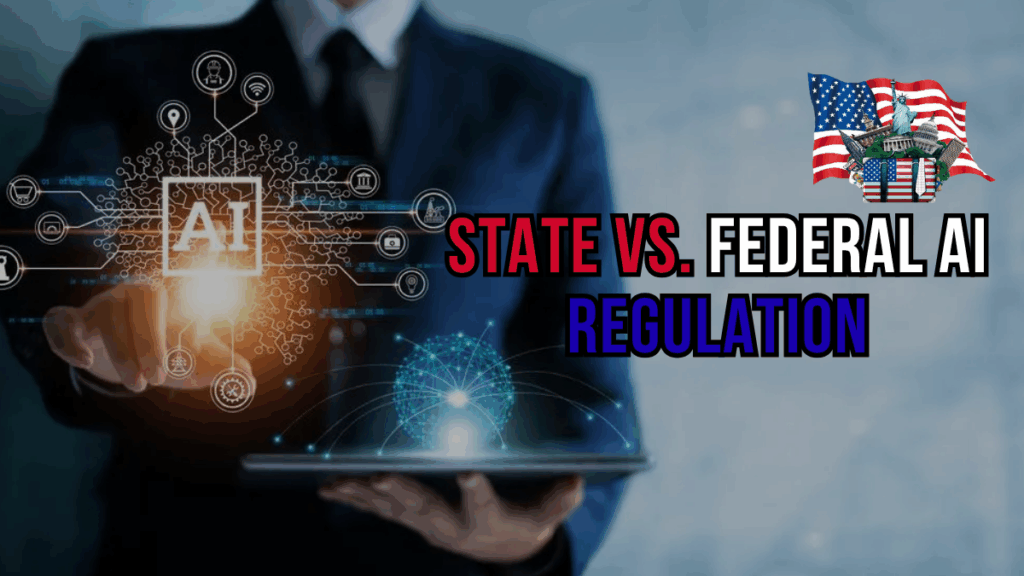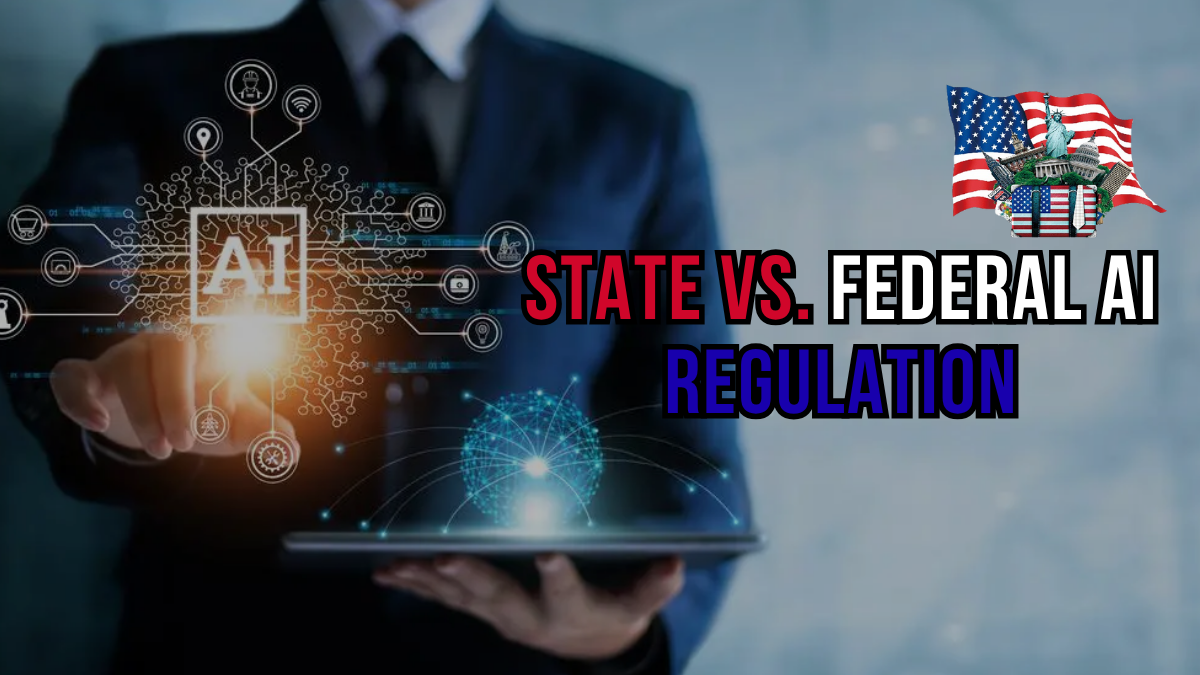The regulatory landscape for artificial intelligence is rapidly evolving, with states taking the lead while federal lawmakers struggle to keep pace. This tension has created a complex web of rules that businesses must navigate, sparking intense debate about who should control AI oversight in America.

As AI technology advances at breakneck speed, the question isn’t whether regulation is needed. It’s who who gets to write the rules. States across the country are implementing their own AI laws, creating a patchwork of requirements that some argue is necessary innovation, while others see it as a compliance nightmare that threatens American competitiveness.
The State-Led Regulatory Revolution
US states introduced nearly 700 AI-related legislative proposals in 2024, a dramatic increase from just 191 bills in 2023. This surge reflects growing concern about AI’s impact on employment, privacy, and civil rights. Of these proposals, 113 were enacted into law, covering everything from deepfakes and digital replicas to government AI applications.
California leads the charge with comprehensive legislation like the Bolstering Online Transparency (BOT) Act, which requires disclosure of automated bots in online interactions. Colorado’s Artificial Intelligence Act, set to take effect in February 2026, goes even further by mandating impact assessments for high-risk AI systems and requiring detailed documentation from developers.
Key State Initiatives
Several states have taken unique approaches to AI regulation:
Illinois focuses heavily on employment protections, requiring employers to notify workers when AI is used in hiring decisions and prohibiting discriminatory AI applications.
New York City’s Local Law 144 requires independent audits of automated employment decision tools to assess potential bias.
Florida and Tennessee have targeted specific harms, with Florida criminalizing AI-generated child sexual abuse material and Tennessee protecting artists from unauthorized AI voice cloning through the ELVIS Act.
Utah established the first Office of Artificial Intelligence Policy, creating a framework for consumer protection and business accountability.
These diverse approaches reflect different priorities and concerns, from protecting workers to safeguarding creative industries.
The Federal Response Dilemma
While states forge ahead, federal action remains limited. The Biden administration has issued executive orders and guidelines, but comprehensive federal legislation has yet to emerge. This vacuum has intensified the debate over regulatory authority.
Senator Edward J. Markey has championed the Artificial Intelligence Civil Rights Act, which would eliminate algorithmic bias and establish guardrails for AI decision-making. The legislation has garnered support from 80 civil rights organizations but faces an uncertain path through Congress.
Senator John Hickenlooper advocates for transparency standards, suggesting that the National Institute of Standards and Technology (NIST) should lead federal AI oversight efforts rather than creating a new regulatory agency.
The Tech Industry’s Push for Federal Control
Major technology companies are increasingly vocal about the need for federal preemption of state AI laws. A recent proposal for a 10-year moratorium on state-level AI regulation has sparked fierce debate.
OpenAI and other tech giants argue that conflicting state regulations create an impossible compliance burden for companies operating across multiple jurisdictions. They contend that a unified federal framework would provide consistent guidelines and maintain America’s competitive edge in the global AI race.
However, critics view this push as an attempt to weaken existing protections. Amba Kak, co-executive director of the AI Now Institute, called the moratorium proposal “absurd,” warning it could freeze progress in AI oversight.
The Compliance Challenge
The current regulatory patchwork creates significant challenges for businesses. Companies must navigate different requirements across states, from Colorado’s impact assessments to Illinois’s employment notification rules.
“The growing quilt of state AI laws presents serious compliance problems for businesses, especially those that serve multiple states,” notes AI consultant Suriel Arellano. “Each state’s understanding of privacy and AI governance is different, which makes the legal landscape hard to navigate and likely raises our costs.”
This complexity has led some companies to adopt the most stringent requirements across all their operations, effectively allowing the most aggressive state regulations to set national standards.
Key Areas of Regulatory Focus
State AI laws typically address several common themes:
Algorithmic Bias and Discrimination: Colorado’s AI Act requires developers to prevent algorithmic discrimination, while Illinois prohibits AI systems that result in protected class discrimination.
Employment Decisions: Multiple states regulate AI use in hiring, with requirements for disclosure, auditing, and human oversight.
Political Transparency: States like Florida, Wisconsin, and New Mexico require disclaimers when AI generates political advertisement content.
Consumer Protection: Utah’s legislation holds businesses accountable for AI-generated content that violates consumer protection laws.
Government Use: Many states have established task forces and frameworks for ethical AI use in government operations.
The Innovation vs. Protection Debate
The tension between fostering innovation and protecting consumers lies at the heart of the federal versus state debate. Proponents of federal regulation argue that uniform standards would eliminate compliance burdens and allow companies to focus on innovation rather than navigating conflicting requirements.
State regulation advocates counter that local control allows for experimentation and tailored solutions. They argue that states can move faster than federal agencies and better understand their constituents’ specific needs and concerns.
Technology lawyer Deniz Celikkaya suggests that regulatory sandboxes could help bridge this gap, allowing companies to experiment with AI under supervision while maintaining oversight.
Looking Ahead: The Future of AI Governance
As the debate continues, several trends are emerging:
Increased Activity: With 45 states actively addressing AI legislation in 2024, regulatory activity is expected to accelerate in 2025.
Sectoral Approaches: Rather than comprehensive frameworks, many states are focusing on specific applications like employment, political advertising, or child protection.
Federal Pressure: The tech industry’s push for federal preemption is likely to intensify as compliance costs mount.
International Considerations: The European Union’s AI Act and other international regulations may influence the direction of US policy.
Finding the Right Balance
The challenge for policymakers is creating a regulatory framework that protects consumers and civil rights while preserving America’s leadership in AI innovation. This requires balancing several competing interests:
- Ensuring consistent standards across jurisdictions
- Maintaining flexibility for emerging technologies
- Protecting vulnerable populations from AI harms
- Preserving competitive advantages for US companies
The outcome of this debate will significantly shape how AI develops and deploys in the United States for years to come.
FAQs: Frequently Asked Questions
Q. What is the difference between state and federal AI regulation?
A. State AI regulation refers to laws and policies enacted at the state level, allowing for localized governance and addressing region-specific concerns. Federal AI regulation, on the other hand, is implemented at the national level, aiming for a unified framework across all states to ensure consistency and wide-reaching oversight.
Q. Why are states pushing for AI regulation now?
A. States are moving forward with AI regulation due to the rapid integration of AI technologies in areas like healthcare, transportation, and employment. State governments seek to protect their citizens by addressing ethical, safety, and privacy concerns while federal policies are still under development.
Q. Why do tech companies favor federal AI regulation?
A. Tech companies prefer federal regulation to avoid navigating a fragmented patchwork of state laws. A unified federal framework ensures consistent compliance standards and reduces operational challenges for companies operating across multiple states.
Q. How do AI regulations impact innovation?
A. AI regulations can both hinder and foster innovation. Overregulation may stifle creativity and create barriers to entry for smaller firms, while well-balanced regulations can provide clarity, protect users, and build trust, ultimately encouraging innovation.
Q. What happens if there is no federal AI regulation?
A. Without federal AI regulation, the U.S. could face significant disparities in AI governance across states. This patchwork approach could result in compliance challenges for businesses, uneven protection for consumers, and missed opportunities for cohesive national leadership in AI development and ethical standards.
The Path Forward
As AI continues to transform industries and society, the regulatory landscape will undoubtedly evolve. The current state-led approach has demonstrated both the benefits of local innovation and the challenges of fragmented oversight.
Whether through comprehensive federal legislation, continued state experimentation, or some hybrid approach, the goal remains the same: harnessing AI’s benefits while mitigating its risks. The stakeholders who succeed in this environment will be those who can navigate complexity, adapt to changing requirements, and maintain a commitment to responsible AI development.
The battle between state and federal AI regulation reflects broader questions about governance, innovation, and protection in the digital age. As this debate unfolds, one thing is clear: the decisions made today will shape the AI landscape for generations to come.
For More Information Click HERE

